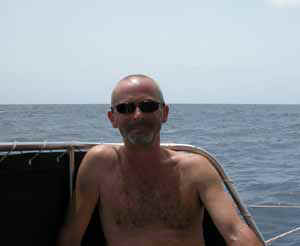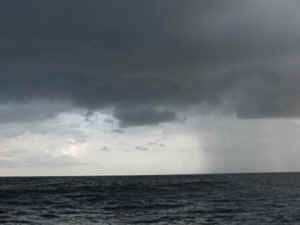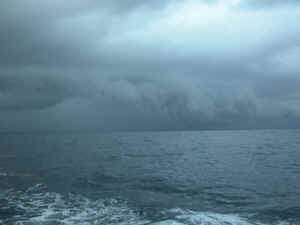
| There are a number of advantages in leaving the Cape Verdes to cross the Atlantic, rather than say La Gomera. Firstly, it's a shorter trip, but also the charms of the Cape Verdes we found pretty limited so that leaving was easier to do. Golden Fleece had set off from one of the northern islands about a week earlier and we'd been speaking to them on HF radio each evening. They weren't having a particularly easy trip and this made us study the weather forecasts even more closely than normal. Finally though, on 26th May 2007 at 1500 we hauled our anchor and set sail for the New World! Half an hour later and well into the night, we were thinking we'd made a very serious mistake, as we rolled in unpleasant seas with near gale force winds. By dawn the following day though things had settled down and we were experiencing the strong (though rolly) downwind sailing that the trade winds are supposed to be about. The sea and strong winds we'd experienced for the first 12 hours had been the result of the acceleration caused by the wind being squeezed between the islands behind us. We were familiar with these wind accelerations zones, but had never expected such dramatic effects still to be felt 50 miles distant from these small islands. | |||
| Life settled down into the the routine that we've
already described. I shaved my head, for which I'm sure there was a good
nautical reason though now, seeing the photo, I can't quite remember what!
Our main preoccupation was with weather and trying to select the optimum point for crossing the ITCZ (Doldrums). As well as the calms that this area is famous for it is also an area of unpleasant sloppy seas as the different wave trains from north and south of the equator collide, and significant thunderstorm and squall activity. At this time of year the zone stretches across the Atlantic about 5º north of the equator, but it is neither constant in width nor position. We expected it to be about 250 miles wide and were planning to motor through it, but we really wanted, if at all possible, to avoid the thunderstorms. A yacht mast at sea is the highest thing for hundreds of miles which makes it very vulnerable to lightning, and a lightning strike can destroy every piece of electrical equipment on board. We received ITCZ weather info from New Orleans every evening, which also showed the location of thunderstorm activity, so we weren't completely blind, but they are what meteorologists call "short term events" which is shorthand for saying that they're not very good at predicting them. In the event we were lucky/successful and didn't see a single flash of lightning. The ITCZ did however move south as we did so it took longer than planned to get through it, but at 1500 on the 1st June the wind filled in, we switched off the engine and we were through. This day was also the 4 year anniversary of setting sail from Eastbourne to begin our trip - it seemed a lifetime away. |
 |
||
|
Two days later at 0615, just as we changed watches, we crossed the equator - another milestone. We had champagne on ice for this, but hadn't reckoned on it happening at dawn. Some traditions are too strong to ignore though so we poured a glass each and one for Poseidon/Neptune and were joined at that moment by a school of small Atlantic dolphin - quite magical. Another 2 days and another milestone - we completed our first 10,000 miles aboard Samarang. Actually, we completed 9,999 and then sat stupidly watching as the GPS fail to click over before realising that it had no more digits and now needed to be reset to zero. That evening Golden Fleece arrived in Salvador and that night the birds came...... It was just after nightfall and Lindy was on watch when the first bird landed on the targa arch. This happens from time to time and being roughly a thousand miles from land we never objected to these hitchhikers - though this one was larger and less attractive than our normal avian companions. Then the second one, and the third. There were a small handful of them circling and trying to land. This still wouldn't really have been a problem except that they seemed to be incredibly territorial and squawked harshly at each other incessantly both during and after landing - a manoeuvre they obviously found quite tricky. They were also incredibly fearless and hard to budge! We resorted to climbing onto our rope chest and poking them off with a broom. They needed a really robust poke too - it was no good just moving them a bit - you had to physically clear them off the boat. Then you had to stop them landing again. This was accomplished either by shining our 2 million candlepower spotlight in their eyes just as they came in to land or by hitting them with the broom whilst in flight. Very spooky, very Hitchcock, but it certainly passed the night. Then at dawn they were gone and we never saw them again. |
|||
 |
The following day the squalls started, which were to continue for the next 4 days or so until we arrived in Brazil. These consisted of torrential rain preceded by winds up to gale force and then followed by flat calms. They were generally short-lived and we could see them coming, both on radar and in reality, so they weren't dangerous, but the constant reefing, and un-reefing was exhausting. In the end we settled for leaving stay sail and fully reefed main as our basic sail plan and rolling the genoa in and out using the electric winch as the squalls blew through. This left us a little under-canvassed once the squalls had passed and cost us a bit of boat speed, but by then we were so tired we didn't really care. |  |
|
|
Neither of us quite recollect when we first became aware of land, it probably came up on the radar first. We both remember not having any particularly strong feeling about it though, which still strikes us as a little strange. We closed the coast very slowly running almost parallel to it for the next 24 hours. Then we picked up the Salvador lighthouse and the cardinal buoy marking the bank south of the entrance and with ominous dark clouds behind us we turned towards the Bay of Bahia. Would the squall hit us or pass us by?? What do you think? It was almost as if the Atlantic had saved its biggest squall as a way of saying goodbye. With 40 knot winds and driving rain we had doubts about whether we'd be able to enter the harbour, but then it was all gone and the sun came out. We dug out mooring lines and fenders and headed in - now trying to get in before dark - and no marina staff in sight. Dave, from another British boat, waved us to an empty berth and Roger and Margaret from Golden Fleece appeared on the pontoon - still on 'automatic' we were there. 2100 miles, 16 days and how did we feel?? Surprisingly little really, we just busied ourselves with all the arrival jobs we had been doing in almost every other harbour for the last 4 years - rig the passerelle so we could get off, connect the power, tighten up the lazy lines etc... the sails would wait for a few days.... then a bottle of champagne on Golden Fleece and Roger promised we would feel elated after a good sleep - perhaps tomorrow! Though whether we would have time for elation tomorrow we weren't sure. As well as the long process of clearing in and becoming legal, we also had a list of inevitable little breakages that always occur on a long voyage. Lindy had broken a molar eating some bread baked on the crossing and I'd popped two hernias, probably pulling up the main sail once too often. Samarang on the other hand, being younger than either of us and much more experienced, had come through virtually unscathed! |
|||